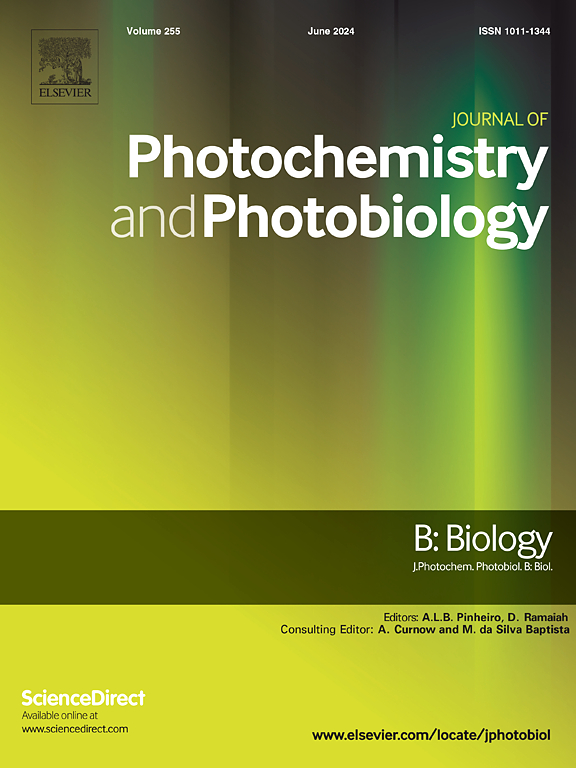Nanobioactive glass/chitosan/collagen composite loaded with methylene blue for tissue regeneration and bacterial infection treatment by photodynamic therapy
IF 3.7
2区 生物学
Q2 BIOCHEMISTRY & MOLECULAR BIOLOGY
Journal of photochemistry and photobiology. B, Biology
Pub Date : 2025-05-06
DOI:10.1016/j.jphotobiol.2025.113179
引用次数: 0
Abstract
Development of suitable tissue engineering scaffolds to be loaded with photosensitizer drugs applied in photodynamic therapy is considered a critical issue. This study we introduced new delivery system based on cerium- and silver-doped nanobioactive glass (nBG)/chitosan/collagen composite scaffolds as a carrier for a photosensitizer, methylene blue (MB), in photodynamic therapy, capitalizing on the unique photocatalytic and antibacterial properties of the doped nBG. Cerium and silver offer additional benefits in terms of antimicrobial, anticancer, and wound healing properties. MB is an effective and inexpensive therapeutic photosensitizer compound that exhibits antimicrobial activity through light activation and has shown great potential for selectively treating infected cells. The prepared scaffolds were characterized by FTIR, TGA, and SEM/EDX. The bioactivity and biodegradation were conducted in SBF. The cell viability was carried out against the WI-38 cell line. Finally, the antibacterial efficiency of scaffolds loaded with MB was evaluated before and after laser irradiation against Staphylococcus aureus, Bacillus subtilis (Gram-Positive), and Pseudomonas aerginousea, klebsiella pneumoniae (Gram-negative). Inhibition of bacteria by reactive oxygen species (ROS) was also measured. Furthermore the primarily MB release profile and kinetic were studied. The results showed that nBG particles increased the thermal stability of the scaffolds, and enhanced the formation of an apatite bone-like layer on the scaffold surfaces. Furthermore, scaffold degradation was tailored by changing the amount of nBG. Moreover, the water uptake of the scaffold containing undoped nBG particles (G010 and G020 samples) showed higher water uptake percentages (682 % and 762 %, respectively) than doped nBG (for 155 % and 322 % for GA10 and GA20, respectively). All scaffolds demonstrated good cell viability at concentrations up to 62.5 μg/ml. However, at higher concentrations, scaffolds incorporating high percentages of nBG were more viable than those containing low amounts of nBG, regardless of the glass composition. The antibacterial tests presented that the MB enhanced scaffold antibacterial efficiency by improving the oxidative stress on bacterial cells, which significantly increased after irradiation. Finally, the release mechanism of MB was diffusion mechanism for scaffolds contained nBG particles, while it did not follow this mechanism for blank polymer scaffolds. In conclusion, these results suggest that the developed multifunctional scaffolds hold significant promise for effective photodynamic antimicrobial chemotherapy in the treatment of microbial infections.
负载亚甲基蓝的纳米生物活性玻璃/壳聚糖/胶原复合材料用于组织再生和光动力治疗细菌感染
开发合适的组织工程支架来装载光敏剂药物用于光动力治疗被认为是一个关键问题。本研究利用掺杂纳米生物活性玻璃(nBG)独特的光催化和抗菌性能,介绍了基于铈和银掺杂纳米生物活性玻璃(nBG)/壳聚糖/胶原蛋白复合支架作为光敏剂亚甲基蓝(MB)光动力治疗载体的新型递送系统。铈和银在抗菌、抗癌和伤口愈合方面提供了额外的好处。MB是一种有效且廉价的治疗性光敏剂化合物,通过光激活表现出抗菌活性,并在选择性治疗感染细胞方面显示出巨大的潜力。用FTIR、TGA、SEM/EDX对制备的支架进行了表征。在SBF中进行了生物活性和生物降解试验。采用WI-38细胞系进行细胞活力测定。最后,对负载MB的支架在激光照射前后对金黄色葡萄球菌、枯草芽孢杆菌(革兰氏阳性)和脓毒杆菌假单胞菌、肺炎克雷伯菌(革兰氏阴性)的抑菌效果进行评价。还测定了活性氧(ROS)对细菌的抑制作用。此外,还研究了主要MB的释放曲线和动力学。结果表明,nBG颗粒提高了支架的热稳定性,促进了支架表面磷灰石样骨层的形成。此外,通过改变nBG的量来定制支架降解。此外,含有未掺杂nBG颗粒的支架(G010和G020样品)的吸水率(分别为682%和762%)高于掺杂nBG的支架(GA10和GA20分别为155%和322%)。所有支架在浓度高达62.5 μg/ml时均表现出良好的细胞活力。然而,在更高的浓度下,无论玻璃成分如何,含有高比例nBG的支架比含有低含量nBG的支架更有活力。抗菌实验表明,MB通过改善细菌细胞的氧化应激来提高支架的抗菌效率,辐照后明显增加。最后,在含有nBG颗粒的支架中,MB的释放机制为扩散机制,而在空白聚合物支架中则不遵循这一机制。总之,这些结果表明,所开发的多功能支架在治疗微生物感染的有效光动力抗菌化疗中具有重要的前景。
本文章由计算机程序翻译,如有差异,请以英文原文为准。
求助全文
约1分钟内获得全文
求助全文
来源期刊
CiteScore
12.10
自引率
1.90%
发文量
161
审稿时长
37 days
期刊介绍:
The Journal of Photochemistry and Photobiology B: Biology provides a forum for the publication of papers relating to the various aspects of photobiology, as well as a means for communication in this multidisciplinary field.
The scope includes:
- Bioluminescence
- Chronobiology
- DNA repair
- Environmental photobiology
- Nanotechnology in photobiology
- Photocarcinogenesis
- Photochemistry of biomolecules
- Photodynamic therapy
- Photomedicine
- Photomorphogenesis
- Photomovement
- Photoreception
- Photosensitization
- Photosynthesis
- Phototechnology
- Spectroscopy of biological systems
- UV and visible radiation effects and vision.

 求助内容:
求助内容: 应助结果提醒方式:
应助结果提醒方式:


